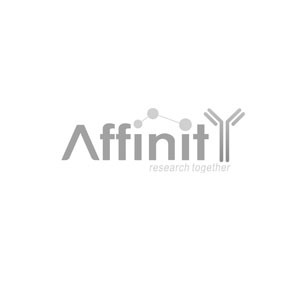REQU Antibody - #DF3380
| Product: | REQU Antibody |
| Catalog: | DF3380 |
| Description: | Rabbit polyclonal antibody to REQU |
| Application: | WB IF/ICC |
| Reactivity: | Human, Mouse |
| Prediction: | Pig, Bovine, Horse, Sheep, Rabbit, Dog |
| Mol.Wt.: | 44 KD; 44kD(Calculated). |
| Uniprot: | Q92785 |
| RRID: | AB_2835762 |
Product Info
*The optimal dilutions should be determined by the end user.
*Tips:
WB: For western blot detection of denatured protein samples. IHC: For immunohistochemical detection of paraffin sections (IHC-p) or frozen sections (IHC-f) of tissue samples. IF/ICC: For immunofluorescence detection of cell samples. ELISA(peptide): For ELISA detection of antigenic peptide.
Cite Format: Affinity Biosciences Cat# DF3380, RRID:AB_2835762.
Fold/Unfold
Apoptosis response zinc finger protein; BAF45D; BRG1-associated factor 45D; D4; D4 zinc and double PHD fingers family 2; double PHD fingers family 2; DPF 2; DPF2; MGC10180; Protein requiem; REQ; REQU_HUMAN; Requiem; Requiem apoptosis response zinc finger; UBI D4; ubi-d4; UBID 4; UBID4; zinc and double PHD fingers family 2; Zinc finger protein ubi d4; Zinc finger protein ubi-d4;
Immunogens
- Q92785 REQU_HUMAN:
- Protein BLAST With
- NCBI/
- ExPASy/
- Uniprot
MAAVVENVVKLLGEQYYKDAMEQCHNYNARLCAERSVRLPFLDSQTGVAQSNCYIWMEKRHRGPGLASGQLYSYPARRWRKKRRAHPPEDPRLSFPSIKPDTDQTLKKEGLISQDGSSLEALLRTDPLEKRGAPDPRVDDDSLGEFPVTNSRARKRILEPDDFLDDLDDEDYEEDTPKRRGKGKSKGKGVGSARKKLDASILEDRDKPYACDICGKRYKNRPGLSYHYAHSHLAEEEGEDKEDSQPPTPVSQRSEEQKSKKGPDGLALPNNYCDFCLGDSKINKKTGQPEELVSCSDCGRSGHPSCLQFTPVMMAAVKTYRWQCIECKCCNICGTSENDDQLLFCDDCDRGYHMYCLTPSMSEPPEGSWSCHLCLDLLKEKASIYQNQNSS
Predictions
Score>80(red) has high confidence and is suggested to be used for WB detection. *The prediction model is mainly based on the alignment of immunogen sequences, the results are for reference only, not as the basis of quality assurance.
High(score>80) Medium(80>score>50) Low(score<50) No confidence
PTMs - Q92785 As Substrate
| Site | PTM Type | Enzyme | Source |
|---|---|---|---|
| A2 | Acetylation | Uniprot | |
| K10 | Sumoylation | Uniprot | |
| K10 | Ubiquitination | Uniprot | |
| R38 | Methylation | Uniprot | |
| K59 | Ubiquitination | Uniprot | |
| R62 | Methylation | Uniprot | |
| Y72 | Phosphorylation | Uniprot | |
| R77 | Methylation | Uniprot | |
| R78 | Methylation | Uniprot | |
| R92 | Methylation | Uniprot | |
| S94 | Phosphorylation | Uniprot | |
| S97 | Phosphorylation | Uniprot | |
| K99 | Sumoylation | Uniprot | |
| K99 | Ubiquitination | Uniprot | |
| K107 | Sumoylation | Uniprot | |
| K108 | Ubiquitination | Uniprot | |
| S113 | Phosphorylation | Uniprot | |
| S117 | Phosphorylation | Uniprot | |
| S118 | Phosphorylation | Uniprot | |
| T125 | Phosphorylation | Uniprot | |
| K130 | Ubiquitination | Uniprot | |
| S142 | Phosphorylation | Uniprot | |
| Y172 | Phosphorylation | Uniprot | |
| T176 | Phosphorylation | P24941 (CDK2) | Uniprot |
| K178 | Ubiquitination | Uniprot | |
| K184 | Acetylation | Uniprot | |
| K186 | Acetylation | Uniprot | |
| K188 | Acetylation | Uniprot | |
| K195 | Acetylation | Uniprot | |
| K195 | Methylation | Uniprot | |
| K196 | Methylation | Uniprot | |
| K196 | Ubiquitination | Uniprot | |
| S200 | Phosphorylation | Uniprot | |
| S231 | Phosphorylation | Uniprot | |
| S244 | Phosphorylation | Uniprot | |
| T248 | Phosphorylation | P24941 (CDK2) | Uniprot |
| S251 | Phosphorylation | P24941 (CDK2) | Uniprot |
| K261 | Acetylation | Uniprot | |
| K261 | Ubiquitination | Uniprot | |
| S280 | Phosphorylation | Uniprot | |
| K285 | Ubiquitination | Uniprot | |
| S305 | Phosphorylation | Uniprot | |
| T310 | Phosphorylation | Uniprot | |
| T358 | Phosphorylation | Uniprot | |
| K381 | Ubiquitination | Uniprot | |
| Y385 | Phosphorylation | Uniprot | |
| S390 | Phosphorylation | Uniprot | |
| S391 | Phosphorylation | Uniprot |
Research Backgrounds
Plays an active role in transcriptional regulation by binding modified histones H3 and H4. Is a negative regulator of myeloid differentiation of hematopoietic progenitor cells. Might also have a role in the development and maturation of lymphoid cells (By similarity). Involved in the regulation of non-canonical NF-kappa-B pathway.
Nucleus. Cytoplasm.
Ubiquitous.
Interacts with the nucleosomes, in particular nucleosomes bearing histone H3 crotonylated at 'Lys-14' (H3K14cr) for which DPF2 has high affinity. Also interacts (via PHD-type zinc finger domains) with histone H3 butyrylated at 'Lys-14' (H3K14bu), histone H3 propionylated at 'Lys-14' (H3K14pr), and histone H3 acetylated at 'Lys-14' (H3K14ac). Interacts with histone H3 acetylated at 'Lys-9' (H3K9ac), histone H3 di-methylated at 'Lys-9' (H3K9me2), and histone H3 tri-methylated at 'Lys-9' (H3K9me3). Interacts with histone H4 acetylated at 'Lys-12' (H4K12ac). Interacts with histone H4 acetylated at 'Lys-16' (H4K16ac). Interacts with SWI/SNF complex components. Interacts with SMARCA2, SMARCA4, SMARCB1 and SMARCD1. Interacts with SMARCC1, SMARCC2 and ACTL6A. Interacts with RUNX1.
Belongs to the requiem/DPF family.
Restrictive clause
Affinity Biosciences tests all products strictly. Citations are provided as a resource for additional applications that have not been validated by Affinity Biosciences. Please choose the appropriate format for each application and consult Materials and Methods sections for additional details about the use of any product in these publications.
For Research Use Only.
Not for use in diagnostic or therapeutic procedures. Not for resale. Not for distribution without written consent. Affinity Biosciences will not be held responsible for patent infringement or other violations that may occur with the use of our products. Affinity Biosciences, Affinity Biosciences Logo and all other trademarks are the property of Affinity Biosciences LTD.
